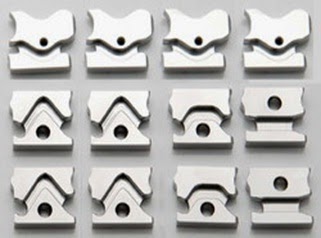Interlock Cam System
Cam:
The cams are the one which commands the various needles movement. Needle butt moves between the grooves of cams. The shape of the needle cam grooves depends on the required knitting pattern. The basic shapes of needle cam are shown in the figure below. The cams are placed outside the needle-bed; each feed system is provided with its own cam group. In Double-bed, two cam frames, one around the cylinder and the other above the dial. All the cams are fixed to a bearing structure called “cam frame”. On single-bed machines, the cam frame is stationary, while the needle-bed revolves i.e. cylinder. Outside the cams, on each feed system, there are special micrometric screws, which adjust the stroke of the lowering cams and determine accurately the length of the yarn feed.
In their simplest structure, the cams are screwed to the cam frame and command a single movement of the needle: for example, when for a certain feed system we only have one group of lowering and rising cams, the selection possibilities will be very restricted. In fact, in this feed system, the needles must knit or remain idle (this is the typical situation of jersey knitting machines). In this case, to modify the pattern it is necessary to change the cam. These technical limits have been overcome by increasing the number of needle butts and the corresponding cam tracks necessary to drive the needle. Now machine manufacturers are able to offer modern single-bed machines with up to 5 selection tracks.
Knitting cam are three types;
The cylinder and dial needle camming to produce one course of ordinary interlock fabric, which is actually the work of two knitting feeders. In this example, the dial has a swing tuck cam that will produce tucking if swung out of the cam-track and knitting if in action.
The cylinder cam system:
A - Clearing cam which lifts the needle to clear the old loop.
B, C -Stitch and guard cams respectively, both vertically adjustable for varying stitch length.
D -Up throw cam, to raise the cylinder needle whilst dial needle knocks- over
E, F -Guard cams, to complete the track.
G, H - Guide cams that provide the track for the idling needles.
The dial cam system:
1- Raising cam to tuck position only.
2, 3- Dial knock-over cams (adjustable).
4 -Guard cam to complete the track.
5 -Auxiliary knock-over cam to prevent the dial needle re-entering the old loop.
6, 7 -Guide cams that provide the track for the idling needles.
8 -Swing type clearing cam, which may occupy the knitting position as shown feeder 1 or the tuck position as shown at feeder 2.
Interlock thus requires eight cam systems or locks in order to produce one complete course, two cam systems for each feeder in each needle bed. Basic cylinder and dial machines and flat-machines having this arrangement are often referred to as eight lock machines.
The cams are the one which commands the various needles movement. Needle butt moves between the grooves of cams. The shape of the needle cam grooves depends on the required knitting pattern. The basic shapes of needle cam are shown in the figure below. The cams are placed outside the needle-bed; each feed system is provided with its own cam group. In Double-bed, two cam frames, one around the cylinder and the other above the dial. All the cams are fixed to a bearing structure called “cam frame”. On single-bed machines, the cam frame is stationary, while the needle-bed revolves i.e. cylinder. Outside the cams, on each feed system, there are special micrometric screws, which adjust the stroke of the lowering cams and determine accurately the length of the yarn feed.
 |
| Cam |
Knitting cam are three types;
- Knit Cam.
- Tuck Cam.
- Miss Cam.
The cylinder and dial needle camming to produce one course of ordinary interlock fabric, which is actually the work of two knitting feeders. In this example, the dial has a swing tuck cam that will produce tucking if swung out of the cam-track and knitting if in action.
 |
| Interlock Cam Arrangement System |
A - Clearing cam which lifts the needle to clear the old loop.
B, C -Stitch and guard cams respectively, both vertically adjustable for varying stitch length.
D -Up throw cam, to raise the cylinder needle whilst dial needle knocks- over
E, F -Guard cams, to complete the track.
G, H - Guide cams that provide the track for the idling needles.
The dial cam system:
1- Raising cam to tuck position only.
2, 3- Dial knock-over cams (adjustable).
4 -Guard cam to complete the track.
5 -Auxiliary knock-over cam to prevent the dial needle re-entering the old loop.
6, 7 -Guide cams that provide the track for the idling needles.
8 -Swing type clearing cam, which may occupy the knitting position as shown feeder 1 or the tuck position as shown at feeder 2.
Interlock thus requires eight cam systems or locks in order to produce one complete course, two cam systems for each feeder in each needle bed. Basic cylinder and dial machines and flat-machines having this arrangement are often referred to as eight lock machines.









{ 0 comments... read them below or add one }
Post a Comment